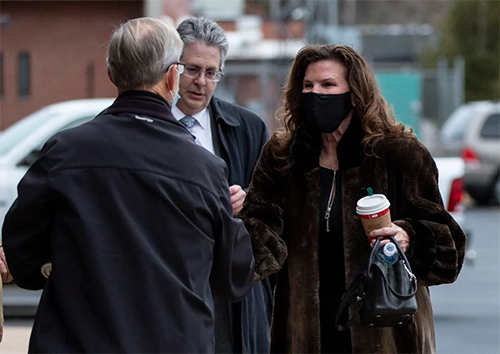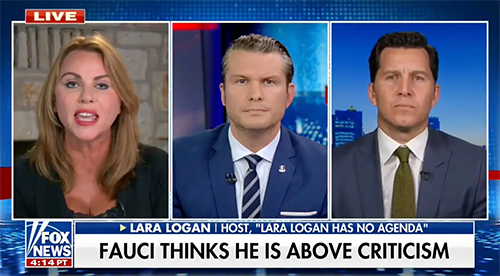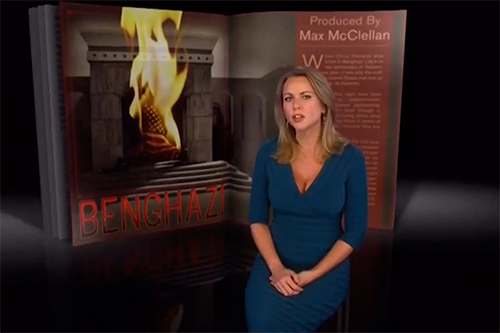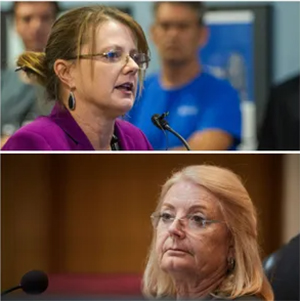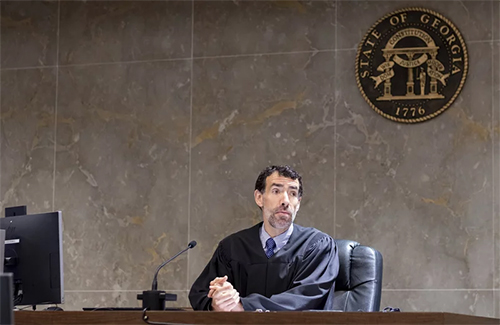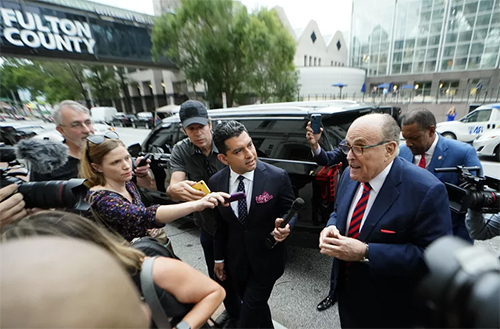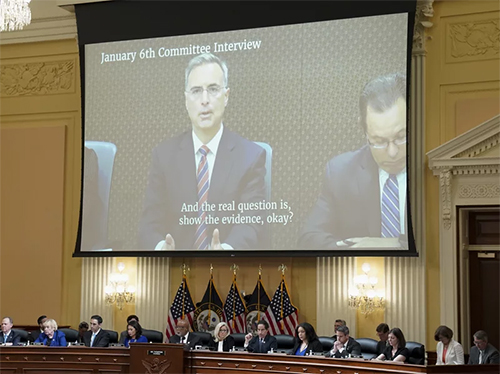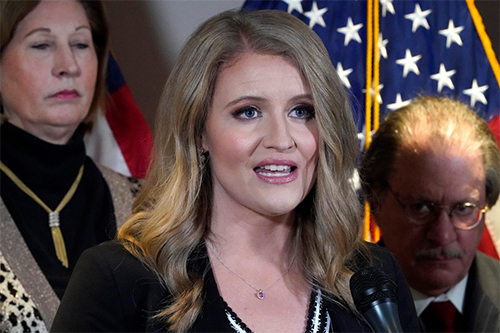Report and Recommendation of Ad Hoc Hearing Committee Re: Preliminary Order of Discipline Charging Rudolph W. Giuliani with violating Pennsylvania Rules of Professional Conduct based on his prosecution of a lawsuit in Pennsylvania following the 2020 presidential election.
by Robert C. Bernius, Esq., Chair
Board on Professional Responsibility, Ad Hoc Hearing Cmte.
July 7, 2023
THIS REPORT IS NOT A FINAL ORDER OF DISCIPLINE* [* Consult the ‘Disciplinary Decisions’ tab on the Board on Professional Responsibility’s website (http://www.dcattorneydiscipline.org) to view any subsequent decisions in this case.]
DISTRICT OF COLUMBIA COURT OF APPEALS
BOARD ON PROFESSIONAL RESPONSIBILITY
AD HOC HEARING COMMITTEE
In the Matter of:
RUDOLPH W. GIULIANI,
Respondent.
A Temporarily Suspended Member of the Bar of the District of Columbia Court of Appeals (Bar Registration No. 237255)
Board Docket No. 22-BD-027
Disciplinary Docket No. 2020-D253
REPORT AND RECOMMENDATION OF AD HOC HEARING COMMITTEE
INTRODUCTION
Disciplinary Counsel charged Respondent Rudolph W. Giuliani with violating Pennsylvania Rules of Professional Conduct 3.1 and 8.4(d), based on his prosecution of a lawsuit in Pennsylvania following the 2020 presidential election.
The hearing in this disciplinary matter took place on December 5-8 and 15, 2022. Former President Donald Trump waived his attorney-client privilege, and Respondent testified at the hearing about all matters relevant to post-election litigation. Tr. 1207.1
Disciplinary Counsel proved by clear and convincing evidence that Mr. Giuliani violated Rules 3.1 and 8.4(d). See Board Rule 11.6; In re Cater, 887 A.2d 1, 24 (D.C. 2005). He violated Pennsylvania Rule 3.1 by filing a lawsuit seeking to change the result of the 2020 presidential election when he had no factual basis, and consequently no legitimate legal grounds, to do so. His prosecution of the lawsuit also seriously undermined the administration of justice and violated Pennsylvania Rule 8.4(d).
The right to vote is the “essence of a democratic society.” Reynolds v. Sims, 377 U.S. 533, 555 (1964). Respondent’s frivolous lawsuit attempted unjustifiably and without precedent to disenfranchise hundreds of thousands of Pennsylvania voters, and ultimately sought to undermine the results of the 2020 presidential election. He claimed massive election fraud but had no evidence of it. By prosecuting that destructive case Mr. Giuliani, a sworn officer of the Court, forfeited his right to practice law. He should be disbarred.
I. FINDINGS OF FACT
1. Respondent Rudolph W. Giuliani is a member of the Bar of the District of Columbia Court of Appeals, admitted on December 2, 1976 and assigned Bar Number 237255. DCX 01. He took inactive (non-practicing) status on December 12, 2002. DCX 02 at 0001; Respondent’s Answer to Specification of Charges at 1. On June 24, 2021, the Supreme Court of the State of New York, Appellate Division, First Judicial Department suspended him pending final disposition of disciplinary proceedings in that jurisdiction. In re Giuliani, 146 N.Y.S.3d 226, 283 (App. Div. 2021) (per curiam). On July 7, 2021, the D.C. Court of Appeals suspended him based on the New York action. Order, In re Giuliani, D.C. App. No. 21-BG-423 (July 7, 2021).
A. 2020 Election Law in Pennsylvania
2. In 2019, the Commonwealth of Pennsylvania enacted Act 77, which permitted any registered voter to vote by mail upon request. 2019 Pa. Legis. Serv. Act 2019-77 (S.B. 421), sec. 8, § 1301-D; Tr. 552 (Ortiz). The liberalized vote-bymail procedures, combined with the COVID-19 pandemic, led to an increase in Pennsylvania mail-in ballots from 266,208 in the 2016 election to 2,653,688 in 2020.2 RX 06 at 4, ¶ 19. In the 2020 general election, more than one third of Pennsylvanians voted by mail. DCX 16 at 0007.
3. To vote by mail, voters were required to apply for a ballot, but did not have to specify a reason for doing so. Once the application was approved the county election board sent the voter a package which contained a ballot and two envelopes: a smaller, “secrecy” envelope marked “Official Election Ballot” and a larger, outer envelope preprinted with a bar code and voter declaration. DCX 17 at 0021; DCX 18 at 0029; DCX 21 at 0009. Voters were instructed to mark their ballot, seal it in the smaller envelope and, in turn, seal that envelope in the larger envelope. Id. Voters then filled out, dated, and signed a declaration printed on the larger envelope, and mailed it or delivered it in person to the county board of election. Id. On election day, officials “canvassed” the mail-in ballots to verify that the appropriate information was on the outside of the larger envelope, and that nothing written on the secrecy envelope would reveal the voter’s identity, political affiliation, or candidate preference. DCX 17 at 0021. The secrecy ballot was then opened, and the ballot was counted. DCX 18 at 0028-29.
4. Following enactment of Act 77, several lawsuits were filed before the 2020 election to clarify or challenge the new procedures. Tr. 554 (Ortiz). In Pennsylvania Democratic Party v. Boockvar, 238 A.3d 345 (Pa. 2020), the Pennsylvania Supreme Court held that if a county election board determined from the outside envelope that a mail-in ballot was deficient – for example, if the voter failed to sign the declaration – the Act did not require the county board to notify the voter and provide an opportunity to correct the mistake (“Notice and Cure”). DCX 17 at 0019-21; Tr. 554-55 (Ortiz); Tr. 134-35 (Giuliani). The Court, on the other hand, did not preclude counties from doing so. Tr. 135 (Giuliani). In the wake of that decision, some counties chose to implement “Notice and Cure”; others did not. DCX 14 at 0009; Tr. 135-36 (Giuliani).3
5. In In re Nov. 3, 2020 Gen. Election, 240 A.3d 591 (Pa. 2020), the Pennsylvania Supreme Court held that: (a) Act 77 does not permit election boards to compare the signatures on mail-in ballot envelopes with those on voter registration forms; and (b) the Act does not permit partisan election observers to challenge mailin ballots during the canvassing process. DCX 19 at 0012-13; Tr. 556-57 (Ortiz); Tr. 136-38 (Giuliani).
6. In a case brought by the Trump campaign, Donald J. Trump for President, Inc. v. Boockvar, 493 F. Supp. 3d 331 (W.D. Pa. 2020), the U.S. District Court for the Western District of Pennsylvania held that the campaign lacked standing to challenge various Pennsylvania election procedures on a vote dilution theory, which included challenges based on the Electors and Election Clauses of the U.S. Constitution. DCX 18 at 0036-40. In the alternative, the court held that the absence of a signature-comparison process for mail-in ballots did not violate equal protection or substantive due process. DCX 18 at 0052, 0056-60; Tr. 557-561 (Ortiz). The campaign did not appeal that decision. DCX 08 at 0053.
7. On election day, to implement pandemic-compelled social distancing between election workers canvassing mail-in ballots and partisan observers, county election officials erected observational barriers tailored to the physical layouts of individual canvassing sites. DCX 20 at 0003. The Trump campaign objected to the barriers in Philadelphia, but a state trial court denied its request to allow its observers closer access. An intermediate appellate court reversed that decision, (RX 16 at 3 (In re Canvassing Observation, No. 1094, 2020 WL 6551316, at *4 (Pa. Commw. Ct. Nov. 5, 2020)); Tr. 562-63 (Ortiz)), but on further appeal the Pennsylvania Supreme Court approved the barrier placements, holding that “the Election Code does not specify minimum distance parameters for the location” of observers. DCX 20 at 0009 (In re Canvassing Observation, 241 A.3d 339, 351 (Pa. 2020)); Tr. 141-47 (Giuliani); Tr. 563-64 (Ortiz). In the interim, a federal judge worked out an informal settlement to allow observers in Philadelphia closer proximity to canvassing operations. Tr. 564-65 (Ortiz).
B. Post-Election Trump Litigation
8. President Biden won Pennsylvania by a margin of more than 80,000 votes. DCX 22 at 0001-02.
9. The day after the election, November 4, 2020, then-President Trump asked Mr. Giuliani to take charge of post-election litigation challenging the voting results. Tr. 42-43, 45, 481-82, 877-78 (Giuliani). Mr. Giuliani went to a war room in Arlington, Virginia where he immediately met with other attorneys to prepare to bring litigation in approximately ten states (including Pennsylvania). Tr. 483-84 (Giuliani). He intended all of those cases to raise similar claims so they could be consolidated in a single lawsuit that would eventually be heard in the U.S. Supreme Court. Tr. 42-46, 49, 53-54, 483-84, 879, 1188-1190 (Giuliani).
10. The litigation team working for Respondent included multiple attorneys as well as Bernard Kerik (formerly Police Commissioner of New York City (Tr. 812- 13 (Kerik))), whom Respondent engaged as chief investigator. Tr. 457 (Giuliani); Tr. 800 (Bobb); Tr. 821-22, 824-25 (Kerik). Mr. Kerik was asked to coordinate efforts to find evidence of voting improprieties or fraud. Tr. 824-29, 854 (Kerik). In addition, Respondent engaged John Droz (who described his career as “trying to defend science” (Tr. 752-55 (Droz)) to assemble statistical models testing the “legitimacy” of the election. Tr. 758-60, 764, 769-770 (Droz).
11. Mr. Giuliani started to work on litigation specific to Pennsylvania after receiving a telephone call complaining about observational boundaries in Philadelphia during the mail-in ballot canvassing there. Tr. 46-47, 49, 882-86 (Giuliani); Tr. 740-42 (Lewandowski).
12. Election challenges based on state law were required to be brought in state court. Tr. 52-54, 513-16 (Giuliani); DCX 40 at 0006 & n.2. The campaign had lost other cases in the state courts, and local counsel “felt it was a lost cause” to bring post-election challenges there. Tr. 515 (Giuliani). Respondent consequently worked with Pittsburgh attorney Ronald Hicks to prepare a case to be filed in Pennsylvania federal court. DCX 34 at 0141-42; see DCX 05 at 0084; Tr. 51-53, 486-88 (Giuliani).
13. Mr. Giuliani helped draft a complaint on behalf of Donald J. Trump for President, Inc. and on behalf of two individual voters who had mailed defective ballots but had not been given the opportunity to cure them. DCX 05; Tr. 55-56 (Giuliani). The complaint contained seven counts asserting violations of the plaintiffs’ civil rights under 42 U.S.C. § 1983 and the Electors and Elections Clauses of the U.S. Constitution. It named as defendants the Pennsylvania Secretary of State and the election boards of seven counties that had returned majorities for President Biden. DCX 05 at 0001, 0011; Tr. 56-57 (Giuliani); Tr. 566 (Ortiz).
14. The initial Complaint was filed on November 9, 2020, in the Middle District of Pennsylvania. DCX 05 at 0001; Tr. 59 (Giuliani); Tr. 566 (Ortiz). Even though he drafted a meaningful portion (up to 30%) of it, Mr. Giuliani was not admitted to practice in the Middle District and did not sign it. Tr. 57, 59, 489, 899 (Giuliani); see DCX 07.
15. Mr. Hicks withdrew his appearance immediately after filing the Complaint. DCX 09 at 0003; Tr. 61-62 (Giuliani). On November 15, 2020, plaintiffs filed a First Amended Complaint authored by another group of lawyers; it eliminated all but two of the seven original counts. DCX 06; Tr. 61, 490 (Giuliani). Mr. Giuliani did not work on that complaint and did not agree with its more circumscribed approach. Tr. 60-63 (Giuliani).
16. The court admitted Mr. Giuliani pro hac vice on November 17, 2020. DCX 07 at 0002. That same day, he personally argued in opposition to a motion to dismiss the First Amended Complaint. DCX 08. By that time, Mr. Giuliani had prepared a Second Amended Complaint. Tr. 71-72 (Giuliani). He believed that the First Amended Complaint wrongly deleted allegations about widespread election fraud that were important to his national litigation strategy. Tr. 64-68 (Giuliani). During the oral argument, he advised District Judge Matthew Brann that he intended to file another complaint. DCX 08 at 0013; Tr. 71-72 (Giuliani).
17. The day after the oral argument, Mr. Giuliani moved for leave to file the Second Amended Complaint, which reintroduced allegations from the original Complaint and added additional counts, all of which were based either on 42 U.S.C. § 1983 or on the Due Process or Electors and Elections Clauses. DCX 09 at 0001- 04; Tr. 491 (Giuliani). At the core of the additional counts were plaintiffs’ claims of systemic election fraud arising from the establishment of observational boundaries. DCX 09 at 0110-0122. The next day, November 19, 2020, plaintiffs sought a temporary restraining order barring defendants from certifying the result of the 2020 election. DCX 10; DCX 11; Tr. 569 (Ortiz).
18. On November 21, 2020, Judge Brann dismissed the First Amended Complaint and denied leave to file the Second Amended Complaint. He also denied plaintiffs’ request for injunctive relief. DCX 14 at 0017 (Donald J. Trump for President, Inc. v. Boockvar, 502 F. Supp. 3d 899, 923 (M.D. Pa. 2020)).
19. Plaintiffs filed a Notice of Appeal on November 22, 2020, signed by Mr. Giuliani. DCX 15. The only issue raised on appeal was whether Judge Brann properly denied leave to file the Second Amended Complaint. DCX 16 at 0005; Tr. 594 (Ortiz).
20. The Third Circuit affirmed dismissal of the case. DCX 16 at 0005 (Donald J. Trump for President, Inc. v. Sec’y of Pennsylvania, 830 Fed. Appx. 377, 382 (3d Cir. 2020)). The court held that the Second Amended Complaint did not contain a sufficient factual basis to state a facially plausible claim to relief. DCX 16 at 0008.
C. The Giuliani Complaints Were Factually Deficient
21. The Complaint and Second Amended Complaint (“Giuliani Complaints”) challenged the location of observational barriers and the existence of Notice and Cure procedures, but neither complaint factually linked either of those circumstances to widespread improper voting. See generally DCX 05; DCX 09. They contained only vague and speculative allegations about random and isolated electoral irregularities which did not and could not support Respondent’s inflated legal claims. See ODC Proposed Finding of Fact (“PFF”) 34 (listing the 26 factual allegations in the two complaints); ODC Reply Br. at 4-5.4
22. For that reason, the District Court found that plaintiffs had presented only “strained legal arguments without merit and speculative accusations, unpled in the operative complaint and unsupported by evidence.” DCX 14 at 0008 (502 F. Supp. 3d at 906).
23. The Third Circuit agreed, holding that the Second Amended Complaint:
never alleges that any ballot was fraudulent or cast by an illegal voter. It never alleges that any defendant treated the Trump campaign or its votes worse than it treated the Biden campaign or its votes. Calling something discrimination does not make it so.
DCX 16 at 0012 (830 Fed. Appx. at 391).
D. Respondent’s Oral Argument to the District Court
24. When Mr. Giuliani opposed the motion to dismiss before Judge Brann, the First Amended Complaint was in effect. It had eliminated claims that were based on observational barriers and fraud. Tr. 60, 71, 490 (Giuliani). Compare DCX 05, with DCX 06. Mr. Giuliani, however, had already drafted the Second Amended Complaint reasserting that observational barriers and Notice and Cure practices had caused widespread fraud. Tr. 71-72, 944 (Giuliani). He justified the amendment “because as compared to last week, we have twice as much evidence this week.” DCX 08 at 0022; see DCX 09 at 0001 (seeking leave to add claims in a second amended complaint “based on newly learned facts”).
25. Mr. Giuliani’s oral argument for the most part elaborated on the observational boundary fraud claims of his Second Amended Complaint. DCX 08 at 0012-18; Tr. 71-73 (Giuliani); Tr. 582-86 (Ortiz).
26. The Pennsylvania Supreme Court, in In re Canvassing Observation, 241 A.3d at 346-47, noted that the Election Board in Philadelphia County had established its observational distancing requirements based “on its perceived need for protecting its workers’ safety from COVID-19 and physical assault from those individuals who have contact with its workers; ensuring security of the ballots; efficiently processing large numbers of ballots; protecting the privacy of voters; and ensuring campaign access to the canvassing proceedings . . . .” DCX 20 at 0006.
27. Mr. Giuliani, however, contended that observational boundaries were a per se fraud that he had “personally witnessed” (Tr. 49 (Giuliani)). He claimed they were “a deliberate scheme of intentional and purposeful discrimination” against the Trump campaign (DCX 09 at 0079-0080, ¶ 167), concluding that Democrats “stole an election . . . in this Commonwealth” (DCX 08 at 0027) and that he had “hundreds of affidavits” supporting his assertion (DCX 08 at 0027-28). These claims were simply not true.
28. Mr. Giuliani did not offer any evidence that fraudulent mail-in votes were actually cast or counted. Tr. 381-82 (Giuliani); Tr. 593 (Ortiz); DCX 40 at 0013-27; see DCX 08. In his view, the existence of observational boundaries was enough: the voter “might not have done anything wrong, but [because of the boundaries] the person counting did something wrong and therefore they’re not counted.” Tr. 334 (Giuliani). The only evidence he offered to the court were photographs showing that observers could not see the details of ballots at canvassing sites in Philadelphia and Allegheny Counties. DCX 08 at 0029-31. Because canvassing absentee and mail ballots subject to observational boundaries was a “planned fraudulent process,” he argued, virtually all of the 682,770 mail-in ballots in Philadelphia and Allegheny counties should not have been counted. Id. at 0023- 26, 0116-17; see also Tr. 383-85, 388-89 (Giuliani). Acknowledging that observational boundaries applied equally to both parties, he rationalized that “Democrats weren’t allowed to see it because they couldn’t count on the fact that all Democrats are crooked.” DCX 08 at 0026-27; see also Tr. 194-95 (Giuliani).
29. Mr. Giuliani’s observational boundaries theory was premised on a conclusive presumption of irregularity, i.e., the wholly unfounded supposition that observational boundaries necessarily led to fraudulent counting of mail-in ballots to favor President Biden. See DCX 05 at 0070 (“Consequently, Defendants created a system whereby it was physically impossible for the candidates and political parties to view the ballots and verify that illegally cast ballots were not opened and counted.”); DCX 09 at 0080 (“Defendant County Election Boards carried out this scheme knowing that the absentee and mail ballots which should have been disqualified would overwhelmingly favor Biden . . . .”); id. at 0088 (same). While the number of Democrats voting by mail was expected greatly to surpass the number of Republicans voting by mail, nothing in the record supports Respondent’s thesis that the observational barriers were put in place to avoid detection of a scheme illegally to count Biden votes.
30. The day that Mr. Giuliani made his oral argument, the Pennsylvania Supreme Court held that the observational boundaries did not violate the election code. DCX 20 at 0009 (In re Canvassing Observation, 241 A.3d at 351).
31. Distinct from the observational boundaries claim, Mr. Giuliani’s Notice and Cure claim was lodged on behalf of two individuals who had mailed in defective ballots that were properly rejected by election officials. DCX 08 at 0019-0020. Rather than seeking to have their votes counted, Mr. Giuliani sued seven other counties that had implemented a Notice and Cure process, seeking on an equal protection theory to take away votes in those defendant counties or even “declar[e] a new election.” Tr. 187 (Giuliani).
32. Claiming that time constraints precluded him from doing so, Mr. Giuliani’s pre-litigation investigation unearthed no evidence of systemic fraud. DCX 08 at 0022-23; Tr. 382 (Giuliani). He briefly visited Philadelphia, and while there focused his attention on the observational boundary restrictions. Tr. 468-475, 1163-1173 (Giuliani). Most of the inspectors with whom he spoke were “in a state of shock” over how the new boundaries differed from practices under prior law. Tr. 1170 (Giuliani); see also Tr. 1173, 1199 (Giuliani).5 None of his interactions, however, unearthed credible proof that observational boundaries or Notice and Cure procedures facilitated widespread fraud. Tr. 234-240, 956-971 (Giuliani).
33. Respondent thus commenced litigation without evidence that its core factual claim was true. He admits as much, maintaining that the “fastmoving” case “did not permit him to investigate fully his client’s position as he would normally do in any other case.” Respondent’s Br. at 2. Even without supporting evidence, he claims, it was reasonable for him to “draw an inference and make an argument that the vote count was illegal and contrary to law.” Id. at 3. We reject this argument.6
34. Despite the lack of proof, Respondent sought an order prohibiting the defendants from counting ballots that had been “cured” and any ballots that had been pre-canvassed or canvassed without “meaningful observation” from poll watchers. DCX 09 at 0113, 0123. Such a remedy would mean disqualifying all mail-in ballots in the defendant counties. Tr. 178-79 (Giuliani). His complaints sought injunctive relief ranging from a prohibition on certifying the results of the 2020 general election (DCX 05 at 0084; DCX 06 at 0062; DCX 09 at 0020, 0122-23; Tr. 577-79 (Ortiz as to DCX 09)) to ordering the Pennsylvania General Assembly to choose the electors (DCX 09 at 0123; Tr. 579-581 (Ortiz)). In his motion for leave to file the Second Amended Complaint, he stated that “[u]ltimately, Plaintiffs will seek the remedy of Trump being declared the winner of the legal votes cast in Pennsylvania . . . and, thus, the recipient of Pennsylvania’s electors.” DCX 09 at 0008-09; Tr. 576 (Ortiz).
35. Four days after the oral argument, the District Court dismissed the case and denied leave to replead. DCX 14.
36. The chief factual objective of the hearing in this disciplinary matter was to ascertain whether Disciplinary Counsel proved by clear and convincing evidence that Mr. Giuliani lacked material evidence to support his claims that observational boundaries and Notice and Cure procedures facilitated widespread, systemic voter fraud and justified the nullification of hundreds of thousands of votes in Pennsylvania. The hearing clearly and convincingly disclosed that there was no such evidence: Respondent based the Pennsylvania litigation only on speculation, mistrust, and suspicion.
E. Observational Boundaries Did Not Facilitate Systemic Election Fraud
37. The record of this disciplinary proceeding includes: (a) all documents in the possession of Mr. Hicks’s firm (DCX 23 & 24); (b) all documents in the possession of Linda Kerns, who signed the Complaint (DCX 05 at 0084-85) and the First Amended Complaint (DCX 06 at 0063) (DCX 25 & 26); (c) all documents in the possession of the law firm that authored the Second Amended Complaint (DCX 09 at 0124) (DCX 27 & 28); (d) all documents in the possession of Mr. Giuliani (DCX 32, 35, 36, 37; Tr. 506-510 (Giuliani)); and (e) the transcript of a Pennsylvania legislative hearing in which Mr. Giuliani participated on November 25, 2020 (DCX 29), which, he claimed, demonstrated “a pattern in Pennsylvania of so many gross irregularities that . . . presents a very solid evidentiary base, direct and circumstantial, supporting responsible allegations of voter fraud.” DCX 32 at 0002.
38. At the hearing in this case Mr. Giuliani belatedly produced another set of declarations and affidavits, RX 01, along with some emails and text messages, RX 02. Tr. 85-86 (Giuliani). His testimony raised the possibility that some relevant materials may have been lost or not turned over, but the only “missing” document he could think of was already included in his document production, albeit without an unknown number of affidavits he “thought” were attached to it. Tr. 90-94, 210- 14 (Giuliani); DCX 32 at 0072-75. He subsequently testified that there might be other missing documents but, if so, they concerned “an illegal voter, it’s one or two.” Tr. 298-99 (Giuliani). Between the time Disciplinary Counsel commenced its investigation of Respondent and the hearing in this matter, Mr. Giuliani reached out to those with whom he had worked and retrieved relevant documents from them which, in turn, he produced to Disciplinary Counsel. Tr. 509-510 (Giuliani).
39. We conclude therefore that the record of the disciplinary hearing contains all the material evidence gathered by Mr. Giuliani, and on his behalf, to support his claims in the Pennsylvania litigation. His nebulous allusions to the existence of additional material documentation are not credible.
40. The documentary evidence that Respondent did produce is fundamentally vague, speculative, or facially incredible. We have reviewed it and have examined with particularity the materials cited by Respondent in his posthearing filings. Respondent’s PFF 36-37. Although the materials identify a handful of isolated election irregularities, they completely fail to demonstrate that the observational boundaries or Notice and Cure procedures facilitated any meaningful fraud or misconduct that could have possibly affected the outcome of the presidential election.
41. At the disciplinary hearing Mr. Giuliani also offered the testimony of Bernard Kerik and John Droz, who produced additional materials purporting to show election fraud. Tr. 751-787 (Droz) (RX 11); Tr. 810-857 (Kerik) (RX 40-43).
42. Mr. Giuliani did not include Mr. Kerik’s documents in his responses to Disciplinary Counsel’s request for evidence (DCX 32, 35, 36, 37; Tr. 97-98 (Giuliani)) and the three subpoenaed law firms did not produce them. DCX 24, 26, 28. Mr. Giuliani did not mention them in the oral argument before Judge Brann (DCX 08), and Mr. Kerik did not testify at the November 25, 2020 legislative hearing (DCX 29). At the disciplinary hearing Mr. Giuliani at first said he did not recall if or when he may have seen the Kerik materials (Tr. 98 (Giuliani)), and later testified that he saw them before the oral argument in the District Court but could not attest to their veracity. Tr. 456-460 (Giuliani).
43. Even if Mr. Giuliani did have the Kerik documents at a relevant time (and it does not appear that he did), they do not show any connection between observational boundaries or Notice and Cure procedures and election fraud. Mr. Kerik (like Mr. Giuliani) could not and would not confirm that the information contained in the Kerik documents was true (Tr. 827-29 (Kerik)) and could not identify its sources. Tr. 839-842 (Kerik). The content of the Kerik documents is in many instances facially incredible. Indeed, Respondent did not offer the Kerik materials in evidence at the disciplinary hearing for their truth, and they were not admitted for that purpose. Tr. 920. For these reasons, we conclude that the Kerik exhibits (RX 40-43) have no probative value in this matter and do not support the allegations made by Mr. Giuliani in the Pennsylvania litigation.
44. Mr. Droz, who acknowledged no expertise in statistics, testified about an exhibit containing statistical “analyses” prepared by third parties, none of whom testified in this disciplinary matter. Tr. 759 (Droz); see RX 11. Mr. Droz could not and would not attest to the veracity of the exhibit, which Respondent again did not offer into evidence for the truth of its content. Tr. 772-73. Mr. Giuliani knew nothing about the credentials of the exhibit’s authors, or about the underlying data they used. Tr. 943-45 (Giuliani). Although he had the exhibit in his possession and claims to have been impressed with aspects of it (Tr. 906-911 (Giuliani)), he did not submit it to the District Court or rely upon it when making his oral argument. Tr. 944-45 (Giuliani). The Droz exhibit fails to establish any causal connection between observational boundaries or Notice and Cure procedures and election fraud. For these reasons we conclude that the Droz exhibit (RX 11) has no probative value in this matter and does not support the allegations in the Pennsylvania litigation.
F. The Notice and Cure Claim Had No Factual Merit
45. The individual plaintiffs lived in counties that did not adopt Notice and Cure procedures, so defective ballots mailed to those counties were not counted. DCX 05 at 0010 (¶¶ 19 & 20); DCX 06 at 0006-07 (¶¶ 15 & 16), 0058-59 (¶ 158); DCX 09 at 0023-25 (¶¶ 22 & 23), 0096-0103 (Count IV), 0105-109 (Count VI). But Mr. Giuliani did not sue the boards of elections in the counties that disqualified the plaintiffs’ ballots and did not seek to have them counted. Tr. 187 (Giuliani).
46. Instead, Respondent sued seven county boards that did offer Notice and Cure to their voters and sought to disqualify the ballots that had been cast in those counties after voters were notified of a defect in their mail-in ballot. DCX 05 at 0001; DCX 06 at 0001; DCX 09 at 0001; DCX 14 at 0011-12; Tr. 176, 187, 495- 502, 510-12 (Giuliani).
47. In Mr. Giuliani’s view, the divergent Notice and Cure practices among the counties constituted an intentional scheme by the seven counties and the Secretary of State to harm the Trump Campaign. Tr. 76 (Giuliani). However, he produced no evidence to support that claim.
48. In any event, the four most populous defendant counties had an aggregate total of approximately 6,500 Notice and Cure votes. DCX 16 at 0011. Respondent did not dispute that number, nor did he proffer a different one.7 The Third Circuit held that even if the Notice and Cure votes in the remaining counties brought the total to 10,000 voters (and even assuming they all voted for President Biden), the result of the election would not have changed. Id.
49. Mr. Giuliani had no evidence to support a claim that the Notice and Cure procedures affected votes in the defendant counties sufficient to approach President Biden’s 80,000-vote victory margin. Tr. 185 (Giuliani). Without such evidence Mr. Giuliani had no legitimate grounds based on Notice and Cure to seek an “injunction that prohibits Defendants from certifying the results of the 2020 presidential general election in Pennsylvania on a statewide basis . . . and/or [an] injunction that the results of the 2020 presidential general election are defective and providing for the Pennsylvania General Assembly to choose Pennsylvania’s electors.” DCX 09 at 0103-05, 0123.8


